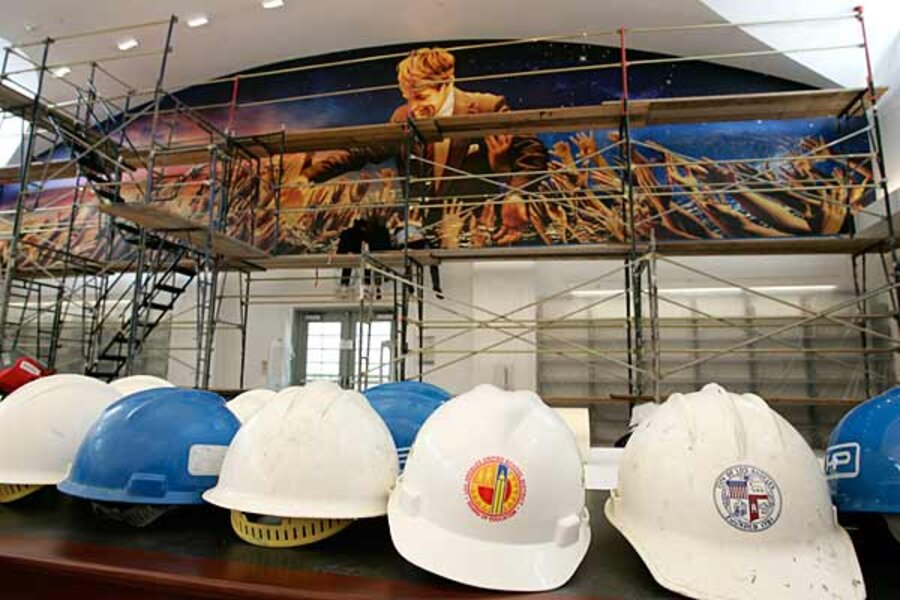How does a $578 million school get built amid cuts, layoffs in L.A.?
Loading...
| Los Angeles
A football-field-sized lawn – lined with walks and trees – stretches from the street to a five-story, glass-front building in this otherwise scruffy neighborhood just west of downtown skyscrapers.
On the site of the Ambassador Hotel, known as the site of Robert F. Kennedy’s assassination in 1968, now sprawl 23 acres of elementary, middle and high school buildings which will serve the poorest, most congested, and diverse district of America’s second-largest school system.
It’s price tag of $578 million makes it the most expensive public school in American history and an easy target of criticism. The Los Angeles Unified School District (LAUSD) has laid off 3,000 teachers in the past two years and is cutting academic programs this year to close a $640 million budget gap.
“When taxpayers see that we’re spending half a billion dollars to build one school, they are not going to open their wallets again to invest in teachers, invest in textbooks and kids, that’s what we need,” says Ben Austin, executive director of Parent Revolution, a coalition of parents formed in 2006 to take back education from politicians, bureaucrats, and special interests.
But backers of the project, including LAUSD superintendent Ramon Cortines, insist the funds spent on the imposing complex aren't being squandered. The money didn’t come from the state’s or even the city’s beleaguered education budget, he says. It came from $20 billion in bond measures approved by voters back in 2006.
“They can’t use any of this money other than for building these particular buildings,” says Mr. Cortines, acknowledging that economic times were dramatically different four years ago. When the buildings were unveiled to the press this week, Cortines mentioned that some of the construction might be over the top – specifically talking benches that commemorate the site’s history. And some national experts have decried the lack of discipline in designing the complex’s manicured 10-acre public park, swimming pool, posh teacher lounges, and an assembly hall modeled after the Cocoanut Grove nightclub.
Likewise, construction experts note that raw material shortages have driven up the cost of buildings to nearly triple since 2002. There are also significant expenses borne in methane gas and earthquake mitigation that schools in other areas don’t have to worry about.
But nationally, some experts speak positively of the uplifting symbolism of such a school, for both communities and students, especially in poorer areas.
"There's no more of the old, windowless cinder block schools of the '70s where kids felt, 'Oh, back to jail,' " said Joe Agron, editor-in-chief of American School & University, a school construction journal, in the Atlanta Journal-Constitution. "Districts want a showpiece for the community, a really impressive environment for learning."
That’s weak logic to critics who feel money should be spent on teachers, not structures.
“New buildings are nice, but when they’re run by the same people who’ve given us a 50 percent drop out rate, they’re a big waste of taxpayer money,” Parent Revolution’s Ben Austin, who also sits on the California Board of Education, told the Associated Press.
"The question the voters may be asking themselves is, 'Could this money have been spread across more schools, more students and more students,' " says Jessica Levinson, political reform director for the Center for Governmental Studies.
"Many would likely prefer to see this large sum spread out to benefit more teachers and students," she says. "The answer is likely that the voter-approved bond measure used to pay for the school designated exactly how those funds should be used – on this new school."





